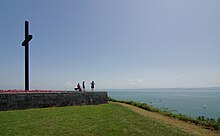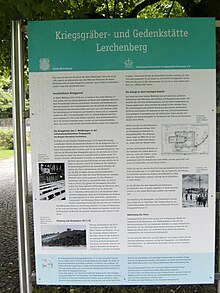German war cemetery Meersburg-Lerchenberg
| graveyard | |
|---|---|

German war cemetery Meersburg-Lerchenberg |
|
| Country: | Germany |
| Region: | Lake Constance district |
| Place: | Meersburg- Lerchenberg |
| Inauguration: | December 17, 1938 Transfer of the dead to Lerchenberg. 1941/42 cessation of construction work. |
The German war cemetery Meersburg-Lerchenberg is a military cemetery on the Höhenweg between Meersburg and Hagnau for 69 German soldiers from the First World War . They died during their treatment as interned wounded or during the exchange of seriously wounded German prisoners of war for seriously wounded French and English prisoners of war in neutral, humanitarian Switzerland .
War dead of the First World War
Wounded prisoners of war from the First World War were taken in by Switzerland for humanitarian reasons with the help of the Swiss Red Cross from German and French camps in Switzerland, interned there and treated in sanatoriums and sanatoriums. The wounded interned German soldiers of the First World War who died in Switzerland were buried in Switzerland. For soldiers buried in Swiss cemeteries, the right of rest expired after 20 years. Therefore, in 1938, 69 German soldiers from the First World War were exhumed in Swiss community cemeteries (Davos, Lucerne etc.), transferred to the Konstanz cemetery hall and then to the memorial in Meersburg and buried in a crypt. The dead are documented by name in the online project Fallen Memorials.
Location in Meersburg
In the extreme southeast of the Meersburg area and on the southern edge of Stetten, about 200 m northeast above the Haltnau winery , lies the Meersburg-Lerchenberg war grave and memorial ("Memorial"). It can be reached via the Höhenweg, a (non-public) road from Meersburg to Hagnau above the vineyards, which is also part of the Lake Constance circular route . The war cemetery to the south is only accessible by car from Stetten (Lake Constance district) .
From there there is a panoramic view of Lake Constance, the mountain peaks of Vorarlberg, Switzerland, as well as Konstanz, the island of Mainau and Meersburg. Next to the memorial there is a stele that marks this place as “Baden's most beautiful view of wine”.
Architectural design
It is an area enclosed with shell limestone walls above the vineyards of Lake Constance . The war cemetery was finally completed in 1964 and is looked after by the Baden-Württemberg regional association of the Volksbund Deutsche Kriegsgräberfürsorge . The crown of thorns and the cross were designed by Werner Gürtner . The redesign of the facility after the Second World War was shaped by Franz Hitzel .
War cemetery and memorial for the missing
On the inside of the Muschelkalk wall above, 70 countries are named in the form of a frieze, in which German soldiers fell or were missing in the First and Second World Wars. This site is also dedicated to the dead, "whose graves are inaccessible to us", and the missing from the two world wars.
Participation of the population and visitors
The war cemetery is located in Meersburg, although no fighting took place on Lake Constance during the world wars. Due to the direct location on the Höhenweg, hikers and cyclists also visit this memorial and this viewpoint. Master stonemasons and master gardeners from Meersburg receive the system. Students from the Überlingen vocational school come to care and commemoration in autumn. But also tour groups with an interest in history lay flowers on the crown of thorns. An international youth group worked in the Hegau-Bodensee region in August 2013 and also looked after the Meersburg-Lerchenberg war cemetery. This youth work was made possible by the Baden-Württemberg regional association of the German War Graves Commission and the city of Singen .
See also
literature
- Diethard Nowak: The war grave and memorial on the Lerchenberg in Meersburg. Meersburg 2012.
Web links
- Website of the Volksbund Deutsche Kriegsgräberfürsorge (work of the Volksbund and description of the war cemetery in Meersburg-Lerchenberg)
- Online project fallen memorials: Stetten (military cemetery), Lake Constance district, Baden-Württemberg
- Information board brightens the background. In: Südkurier of October 21, 2011
swell
- ↑ Information board on the German war cemetery Meersburg-Lerchenberg
- ↑ Helmut Arnold: The Geneva writer Noëlle Roger (1874–1953) and her participation in the internee exchange during the First World War. In: “ Hegau-Geschichtsverein ”, year book 73/2016, pp. 258–260.
- ↑ Online project memorials for fallen: Stetten (military cemetery), Lake Constance district, Baden-Württemberg
- ^ The war cemetery Lerchenberg. In: Voice & Way, 3/2012, p. 26
- ↑ Museumsverein Meersburg (ed.): Meersburg under the swastika 1933-1945 . Robert Gessler Friedrichshafen, Meersburg 2011, ISBN 978-3-86136-164-0 , pp. 411-418.
- ↑ Olav Teichert: In the course of the magazine. 90 years of the Volksbund's membership magazine - 1921–1950. In: Voice & Way. 1/2011, pp. 10-13.
- ^ Diethard Nowak: Small monuments in Meersburger Landen. Meersburg, second expanded edition 2014. pp. 131–132, section: Flötenspielerbrunnen in Kirchstrasse. Reference to Werner Gürtner as the designer of the crown of thorns and cross at the German war cemetery in Meersburg-Lerchenberg.
- ↑ Information board in Meersburg-Lerchenberg, Germany, about the German war cemetery Meersburg-Lerchenberg for the deceased and buried soldiers of the First World War.
- ↑ Source: Joint information board City of Meersburg / Volksbund Deutsche Kriegsgräberfürsorge at the entrance to the memorial.
- ↑ Information board illuminates the background. In: Südkurier of October 21, 2011
- ↑ Volksbund, Landesverband Baden-Württemberg: Tour group visits the war cemetery Lerchenberg
- ↑ Manuela Klaas: Better than any history lesson. In: Südkurier of August 24, 2013.
Coordinates: 47 ° 41 ′ 4.3 ″ N , 9 ° 17 ′ 32.3 ″ E





